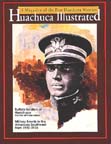 Uniforms: 1910-1939
Uniforms: 1910-1939 The khaki and drab hues of the 1911 uniform models would be the distinctive
coloring of the American soldier's dress for the entire 20th century, although
slight variations in shade would proliferate and camouflage patterns would
replace the solids. These earth colors blended well with the umber, sienna,
and ochre faces at Fort Huachuca, but the uniforms were thought too workaday,
to practical, insipid. They lacked the blaze of color and the plumage that
had marked the 19th century cavalry uniform. Perhaps that is why the blue
and gold full dress uniforms were retained for formal functions.
The khaki and drab hues of the 1911 uniform models would be the distinctive
coloring of the American soldier's dress for the entire 20th century, although
slight variations in shade would proliferate and camouflage patterns would
replace the solids. These earth colors blended well with the umber, sienna,
and ochre faces at Fort Huachuca, but the uniforms were thought too workaday,
to practical, insipid. They lacked the blaze of color and the plumage that
had marked the 19th century cavalry uniform. Perhaps that is why the blue
and gold full dress uniforms were retained for formal functions.
The service uniform of the 1911 pattern, which exhibited a decided British influence, consisted of olive drab breeches, shirt, and service coat with a stand-up collar.
Capt. Charles H. Grierson at Huachuca
in 1915.
Photo courtesy Charles H. Grierson collection.
Chevrons after 1911 were olive drab or khaki except on the dress uniforms which were still the color of the branch of service. Since 1902 they were sewn on the sleeves with "points up."
 The M1911 service uniforms, made virtually of blanket wool, were worn
without the service coat in the summer months, until a cotton material was
prescribed for the summer. This coatless uniform was worn by the Cavalry
that patrolled the border with Mexico and embarked upon the 1916 Punitive
Expedition. The same uniforms, equipment, and weapons were used by the American
Expeditionary Force in France during World War I. Men at Fort Huachuca continued
to wear the 1905 "Montana peak" campaign hat. A hat cord on the
campaign hat denoted the branch of service. Troops in France wore a steel
trench helmet---a British "basin"-pattern helmet painted a drab
color.
The M1911 service uniforms, made virtually of blanket wool, were worn
without the service coat in the summer months, until a cotton material was
prescribed for the summer. This coatless uniform was worn by the Cavalry
that patrolled the border with Mexico and embarked upon the 1916 Punitive
Expedition. The same uniforms, equipment, and weapons were used by the American
Expeditionary Force in France during World War I. Men at Fort Huachuca continued
to wear the 1905 "Montana peak" campaign hat. A hat cord on the
campaign hat denoted the branch of service. Troops in France wore a steel
trench helmet---a British "basin"-pattern helmet painted a drab
color.
"The American Soldier, 1918, Red Cross Nurse,
Army Nurse, Medical Officer, Military Police, Medical Troops,
Ambulance." Charles McBarron.
 A wool OD "overseas" cap replaced the "Montana"
campaign hat in 1917, and was, worn in the rear areas of France. The new
corps insignia disc was worn on the left side. Modeled after a French cap,
the 1918 overseas cap was later to become the field or garrison cap and
in 1940 it was authorized for wear in the U.S. Then a cord was added in
the color of the wearer's branch of service. Officers wore yellow cords
until 1940 when the cord was changed to a gold and black braid.
A wool OD "overseas" cap replaced the "Montana"
campaign hat in 1917, and was, worn in the rear areas of France. The new
corps insignia disc was worn on the left side. Modeled after a French cap,
the 1918 overseas cap was later to become the field or garrison cap and
in 1940 it was authorized for wear in the U.S. Then a cord was added in
the color of the wearer's branch of service. Officers wore yellow cords
until 1940 when the cord was changed to a gold and black braid.
"The American Soldier, 1918, Artillery
Officer,
Machine Gun Sergeant. France. Artillery Firing,
Field Telephone Crew." Charles H. McBarron.
The enlisted infantry replaced their canvas gaiters with OD wool puttees or wraps. Officers continued to wear leather leggings. Cavalrymen during this period wore M1917 canvas leggings reinforced with leather. In. 1918 divisional shoulder patches were authorized for wear. Made of russet leather, the M1921 officer's belt was a modification of the "Sam Browne" belts worn in France by officers of the American Expeditionary Force. It has a dress saber chain attachment (M1924), leather magazine pockets for .45 pistol clips, and a holster for the .45.
Enlisted men began wearing bronze collar disc insignia in 1907 to replace the crossed rifles, sabers, etc. they had worn on the collar since 1901. The 1907 pattern called for the letters "US" on the right collar disc and the branch insignia on the left, with the regimental number above and the company letter below. This style would last until 1917 when the regimental number was taken off the left disc and placed below the "US" on the right disc.

During the 1920s at Fort Huachuca, troopers from the
10th Cavalry considered themselves to
be the elite arm of the service, even though the firepower experienced in
World War I would
quickly make the horse Cavalry obsolete. The mounted soldier shown here
is Pvt. Tom Prowl.

Lt. George Patton with two unidentified aviators after
World War 1.

Enlisted man of the 25th Infantry posing in front
of car.